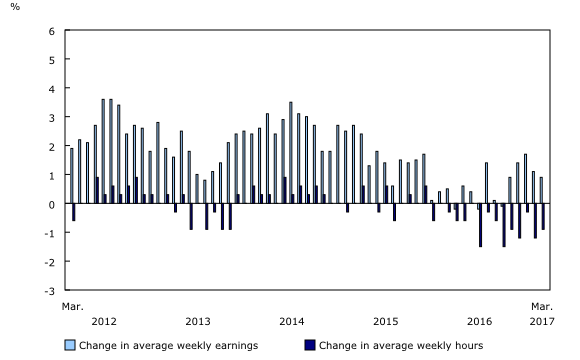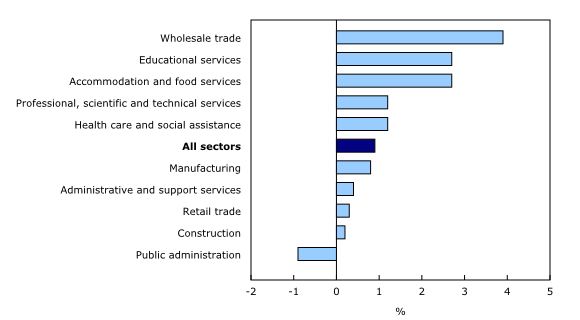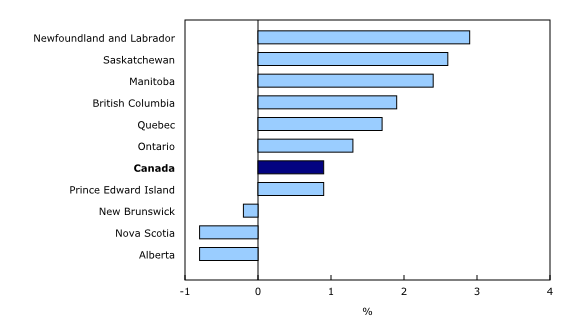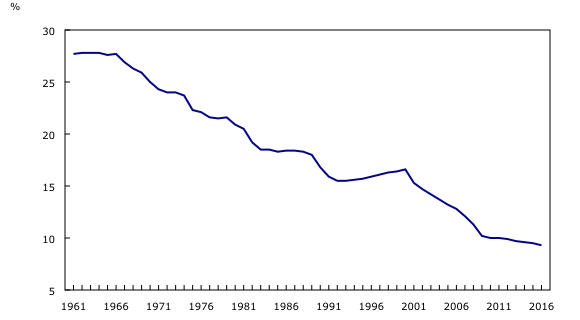Payroll employment, earnings and hours, March 2017
Archived Content
Information identified as archived is provided for reference, research or recordkeeping purposes. It is not subject to the Government of Canada Web Standards and has not been altered or updated since it was archived. Please "contact us" to request a format other than those available.
Released: 2017-05-25
$966.06
March 2017
0.9% 
(12-month change)
$1,037.37
March 2017
2.9% 
(12-month change)
$823.52
March 2017
0.9% 
(12-month change)
$862.04
March 2017
-0.8% 
(12-month change)
$878.95
March 2017
-0.2% 
(12-month change)
$893.18
March 2017
1.7% 
(12-month change)
$982.21
March 2017
1.3% 
(12-month change)
$908.32
March 2017
2.4% 
(12-month change)
$1,008.48
March 2017
2.6% 
(12-month change)
$1,117.59
March 2017
-0.8% 
(12-month change)
$932.94
March 2017
1.9% 
(12-month change)
$1,084.43
March 2017
1.0% 
(12-month change)
$1,411.30
March 2017
-1.5% 
(12-month change)
$1,305.28
March 2017
2.8% 
(12-month change)
Average weekly earnings of non-farm payroll employees were $966 in March, little changed from February and up 0.9% from March 2016.
In general, changes in weekly earnings reflect a number of factors, including wage growth; changes in the composition of employment by industry, occupation and level of job experience; and average hours worked per week.
Non-farm payroll employees worked an average of 32.6 hours per week in March, little changed from February and down from 32.9 hours observed in March 2016.
Average weekly earnings by sector
In the 12 months to March, average weekly earnings rose in 3 of the 10 largest industrial sectors: wholesale trade; accommodation and food services; and educational services. Earnings were little changed in the remaining large sectors.
Average weekly earnings in wholesale trade grew 3.9% to $1,189, with machinery, equipment and supplies wholesalers contributing most to the increase. Several provinces reported earnings growth in this sector, particularly Manitoba, Saskatchewan and Ontario. Earnings in wholesale trade have trended upward since autumn 2016.
Average weekly earnings in accommodation and food services increased 2.7% to $379. A large employment increase in this low-earning sector moderated the year-over-year growth of national average weekly earnings. Most of the earnings growth in this sector was observed in the full-service restaurants and limited-service eating places industry. Newfoundland and Labrador and New Brunswick had the largest increases in average weekly earnings.
In educational services, average weekly earnings were up 2.7% to $1,031, boosted by gains in elementary and secondary schools. The largest increases were observed in Newfoundland and Labrador and Saskatchewan.
Average weekly earnings by province
Compared with March 2016, average weekly earnings of non-farm payroll employees rose in six provinces: Newfoundland and Labrador, followed by Saskatchewan, Manitoba, British Columbia, Quebec and Ontario. There was little change in the remaining provinces.
Average weekly earnings in Newfoundland and Labrador grew 2.9% to $1,037, driven by increases in construction, educational services, and transportation and warehousing. Earnings in the province have been on an upward trend since spring 2016.
In Saskatchewan, average weekly earnings increased 2.6% to $1,008. Earnings growth was spread across several sectors, with educational services, retail trade, wholesale trade, and public administration contributing most to the gains.
Average weekly earnings in Manitoba were up 2.4% to $908, driven by finance and insurance, as well as construction. Earnings in the province have trended upward since October 2016.
In British Columbia, average weekly earnings grew 1.9% to $933, with the largest increases in administrative and support services, manufacturing, and finance and insurance.
Average weekly earnings in Quebec rose 1.7% to $893. Earnings in the province were boosted by notable gains in professional, scientific and technical services, health care and social assistance, and finance and insurance.
In Ontario, average weekly earnings increased 1.3% to $982. Earnings in the province grew most rapidly in wholesale trade and in information and cultural industries.
In Alberta, average weekly earnings were little changed at $1,118. While there were declines in mining, quarrying and oil and gas extraction, and in administrative and support services, earnings in retail trade, construction, and professional, scientific and technical services held steady.
Non-farm payroll employment by sector
The total number of non-farm payroll employees was little changed from February. However, the number of payroll jobs grew in several sectors, with the largest gains in health care and social assistance and mining, quarrying, and oil and gas extraction. At the same time, the number of payroll employees decreased in wholesale trade, construction, and administrative and support services.
Compared with March 2016, the number of non-farm payroll employees was up 265,400 (+1.7%). The largest increases were in health care and social assistance (+40,400 or +2.2%), accommodation and food services (+30,300 or +2.4%), and professional, scientific and technical services (+25,200 or +2.9%). At the same time, there was a decline in wholesale trade (-4,600 or -0.6%).
Recent labour market developments
In the 12 months to March, the pace of employment growth has been similar in both of Statistics Canada's monthly surveys with data on employment: the Survey of Employment, Payrolls and Hours (SEPH) and the Labour Force Survey (LFS).
During this period, both surveys showed employment gains in Ontario, Quebec, British Columbia and New Brunswick, as well as Prince Edward Island. For example, in Prince Edward Island, the number of payroll employees in SEPH grew by 2.4% on a year-over-year basis, outpacing the national average (+1.7%). The LFS also showed strong employment growth in the province during this period, and the unemployment rate edged down to 10.1%.

In celebration of the country's 150th birthday, Statistics Canada is presenting snapshots from our rich statistical history.
The evolution of employment in manufacturing
There was a strong manufacturing sector in Canada in the early 20th century, coinciding with increased urbanization, industrialization and protectionist policies, among other factors. Throughout the 1930s, manufacturing accounted for roughly 30% of paid jobs in Canada. Employment in the sector rose sharply in the early 1940s, representing over 40% of all paid civilian jobs from 1942 to 1945. This was mostly the result of increased demand for weapons, equipment and other products related to the Second World War.
In the late 1950s, Canada's economy shifted from a predominantly goods-based economy to a service-based economy. Manufacturing — part of the goods-producing sector — still accounted for a large proportion of employment at this time, though it was beginning to decline. From the early to mid-1960s, manufacturing accounted for 28% of all paid employees.
By the mid to late-1980s, 18% of paid workers were employed in manufacturing. Despite the decreasing proportion, the absolute number of people employed in the sector increased throughout most of the 20th century, peaking at over 2 million in 1989.
From 1989 to 1993, employment in manufacturing decreased by over 400,000, coinciding with the recession of the early 1990s. In 1993, 15% of paid workers were employed in manufacturing. As the labour market recovered throughout the mid to late-1990s, the proportion of people employed in manufacturing rebounded slightly to 17% by 2000.
Since the turn of the 21st century, employment in manufacturing has trended downward. By 2016, 9% of paid employees worked in the manufacturing sector, the lowest proportion on record.
Sources: "Trends in manufacturing employment," Perspectives on Labour and Income (75-001-X); Table D318-328 in Historical Statistics of Canada (11-516-X), published in July 1999; and "One hundred years of labour force" in Canadian Social Trends (11-008-X).
Note to readers
The Survey of Employment, Payrolls and Hours (SEPH) is produced by a combination of a census of approximately one million payroll deductions provided by the Canada Revenue Agency, and the Business Payrolls Survey, which collects data from a sample of 15,000 establishments. Federal, provincial and territorial public administration data are collected from various administrative records provided by these levels of government. The key objective of the SEPH is to provide a monthly portrait of the level of earnings and the number of jobs and hours worked by detailed industry at the national, provincial and territorial level.
Estimates of average weekly earnings and hours worked are based on a sample and are therefore subject to sampling variability. This analysis focuses on differences between estimates that are statistically significant at the 68% confidence level. Payroll employment estimates are based on a census of administrative data and are not subject to sampling variability.
Statistics Canada also produces employment estimates from its Labour Force Survey (LFS). The LFS is a monthly household survey, the main objective of which is to divide the working-age population into three mutually exclusive groups: the employed (including the self-employed), the unemployed, and those not in the labour force. This survey is the official source for the unemployment rate, and collects data on the socio-demographic characteristics of all those in the labour market.
As a result of conceptual and methodological differences, estimates of changes from SEPH and LFS do differ from time to time. However, the trends in the data are quite similar. To better understand the conceptual differences between employment measures from the LFS and SEPH, refer to section 8 of the Guide to the Survey of Employment, Payrolls and Hours (72-203-G).
Unless otherwise stated, this release presents seasonally adjusted data, which facilitate comparisons by removing the effects of seasonal variations. For more information on seasonal adjustment, see Seasonally adjusted data – Frequently asked questions.
Non-farm payroll employment data are for all hourly and salaried employees, as well as for the "other employees" category, which includes piece-rate and commission-only employees.
Unless otherwise specified, average weekly hours data are for hourly and salaried employees only and exclude businesses that could not be classified to a North American Industry Classification System (NAICS) code.
All earnings data include overtime pay and exclude businesses that could not be classified to a NAICS code. Earnings data are based on gross taxable payroll before source deductions. Average weekly earnings are derived by dividing total weekly earnings by the number of employees.
With each release, data for the current reference month are subject to revision. Data have been revised for the previous month. Users are encouraged to request and use the most up-to-date data for each month.
Real-time CANSIM tables
Real-time CANSIM tables 281-8023, 281-8026, 281-8047 and 281-8063 will be updated on June 12. For more information, consult the document Real-time CANSIM tables.
Next release
Data on payroll employment, earnings and hours for April will be released on June 29.
Products
A summary table is also available.
Job Vacancy Statistics (5202) from the Survey of Employment, Payrolls and Hours for February are now available in CANSIM.
More information about the concepts and use of the Survey of Employment, Payrolls and Hours and Job Vacancy Statistics is available in the Guide to the Survey of Employment, Payrolls and Hours (72-203-G).
Contact information
For more information, contact us (toll-free 1-800-263-1136; 514-283-8300; STATCAN.infostats-infostats.STATCAN@canada.ca).
To enquire about the concepts, methods or data quality of this release, contact Dylan Saunders (613-762-6972; dylan.saunders@canada.ca) or Client Services (toll-free: 1-866-873-8788; statcan.labour-travail.statcan@canada.ca), Labour Statistics Division.
- Date modified:





